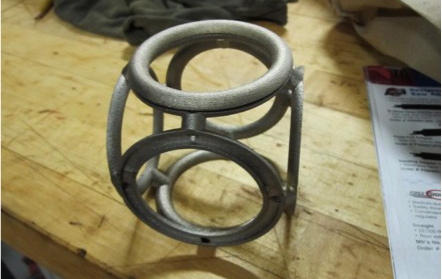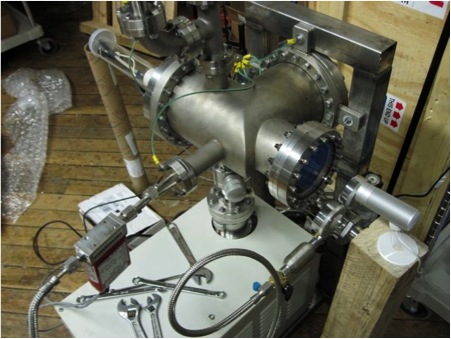Amateur Fusioneer Dreams of Clean Energy
Mark Suppes hopes to solve the world’s energy problems with limitless cheap, clean energy — on a tabletop
Olivia Koski • June 25, 2010
![Mark Suppes outside his Brooklyn lab. [Credit: Olivia Koski.]](http://www.scienceline.org/wp-content/uploads/2010/06/suppes-400x260.jpg)
Mark Suppes outside his Brooklyn lab. [Credit: Olivia Koski.]
Last November, the Gucci web designer turned do-it-yourself fusion engineer Mark Suppes hunched over a silvery chamber with wires and plastic tubes sprouting in every direction. Engrossed in his work, he finally looked up, smiled, and said, “Okay, I think we’re almost ready to fuse the atom.”
Making final preparations in his dusty Brooklyn workshop on his second fusion attempt, Suppes could hardly contain himself. Just a week earlier, he got his first evidence of fusion from a lipstick-case–sized glass chamber called a bubble detector. The device detects neutrons — subatomic particles that are produced during a fusion reaction. He has since been confirmed as the 38th amateur to fuse the atom.
Suppes says many people fail to grasp the point of his audacious project — and the distinction between bomb-making and peaceful energy research. “Ninety percent of the time the reaction is ‘Oh, so you’re going to blow up Brooklyn? Don’t blow up Brooklyn!’ Clearly people are really afraid of it, which kind of sucks,” he said.
Rather than blow up Brooklyn, he hopes to someday give everyone in the borough — and the world — virtually unlimited energy that is clean and cheap, too. While his fusor does produce a beautiful glowing purple ball of charged gas, it’s not yet solving the world’s energy problems. In fact, he acknowledges that his device will never produce net energy. “It’s not a break-even reactor,” he admitted. For him, the fusor is a stepping stone to building something called a Polywell reactor — a fusion technology he believes could change the world.
The Polywell was the brainchild of the late Robert Bussard, a physicist who swore the technology he developed could deliver the promise of real fusion energy that has eluded fusion scientists for decades. DARPA, who funded Bussard’s project, prevented him from publishing the results. Shortly before his 2007 death, the embargo lifted and he claimed he had finally achieved the holy grail of net energy. With the right engineering, Bussard said, the Polywell reactor could be 100,000 times more efficient than any other fusion device. Most mainstream physicists reject the claim out of hand. The company Bussard left behind continues to pursue Polywell research. Suppes is the first person to strike out on his own.

After learning about the Polywell through a Google Talks video, Suppes became obsessed with building one. In contrast to fusion research requiring multimillion-dollar laboratories and giant machines called tokamaks, which use magnets to confine extremely hot, charged gas, the Polywell could be built on a tabletop. It’s an evolution of the fusor Suppes has already built using supplies largely ordered off eBay with a budget of less than $35,000.
Suppes is not the first to dream of solving the world’s energy problems with fusion. Responsible for the most powerful weapon detonated on earth, the hydrogen bomb, nuclear fusion could also potentially provide the world’s cleanest energy source. Yet promises of unlimited power from fusion have invariably fallen flat.
“There’s no way to cheat,” said Rob Goldston, a plasma physicist at Princeton University. “It’s challenging stuff.”
Despite a complete lack of training in nuclear physics, Suppes hopes to be the first amateur in the world to build a Polywell fusion reactor — and eventually succeed where thousands of professional physicists have failed. “I have no doubt that the machine will work,” he said, eyes gleaming.
Suppes has documented every step at his blog, and often used it to get tips from people who follow his work. “It’s not just me working on this. People write comments on my blog. They could write one sentence that doesn’t take much effort for them, but it’s the keys to the kingdom for me.” His project is completely open source. He hopes to inspire others to try their hand at producing cheap energy.
While his latest venture might be his most ambitious, Suppes has always preferred to work for himself. By the time he was twenty-eight, he had already created and sold an online food ordering service. During his initial fusion research he was able to live off of money he had made from previous ventures and freelance development, but eventually had to go back to work full time when his project got low on cash.
When money ran out, he easily got some more through the DIY fundraising website Kickstarter. Within a few days, he was approached by a serious investor from Scandinavia, but the deal fell through. He is itching to secure big-time funding.
What Suppes lacks in technical knowledge he makes up for in enthusiasm. Asked about what he thinks of the skeptics, he laughs. “I’m glad I’m approaching this problem as an entrepreneur rather than a physicist,” he mused.

The computer-controlled fusor he’s built in unexpectedly straightforward to operate. A vacuum chamber the size of a breadbox contains hollow metallic spheres. These pieces of metal are attached to high voltage power lines. A small tank of deuterium — a special type of hydrogen fuel — is connected to the chamber with plastic tubing and a flow control valve. With a single keystroke, Suppes turns up the power and releases the fuel, and the mesmerizing purple glow appears on his computer screen via a live camera feed. The reaction produces X-rays — so it’s advisable to stay a safe distance away to avoid radiation.

With a confirmed fusion reaction under his belt, Suppes is ready to be the first amateur to take on the Polywell. But even if he manages to build a working Polywell, professional fusion scientists are not at all convinced the design can produce more power than it takes in. “The scheme makes neutrons, and makes a nice science project. Using it to solve the world’s energy problems is a bit more complicated, as the power required to sustain these devices tends to be larger than the fusion power produced,” explained William Nevins, a fusion scientist at Lawrence Livermore National Laboratory in California.
Nevins challenged Bussard’s claims about the Polywell in a paper published in Physics of Plasmas in 1995. He estimated you would need to put 100,000 watts of power into the reactor to get just 1 watt out. If that’s the case, the Polywell would make a horrible power plant.
So far, the most favorable energy balance any fusion machine has achieved is about 10:1, and physicists have been steadily improving the ratio over decades with better tokamak-based designs. “We’ve systematically gone up from a tenth of a watt to ten million watts of fusion power in our experiments,” explained Goldston. The devices he manages at Princeton are producing more power than they consume, but not yet enough to be used as power plants. Considering the amount of work he’s put into the problem over a span of decades, Goldston is skeptical of claims that a relatively untested, new design can do better than systems that have been steadily refined.
While Goldston sees nothing wrong with pursuing out-there ideas in fusion, he doesn’t believe that inertial electrostatic confinement — the Polywell’s design — is the way to go. “It’s been proven over and over again to be wrong,” he says.
That doesn’t put off Suppes in the slightest. He hopes to some day look back and say, “Remember back in 2010 when we were wringing our hands about energy?”
5 Comments
Good article.
A paper by Luis Chacon has shown Nevins is probably wrong. Polywells may not pan out, but they’re more plausible than is often stated. We will find out pretty soon what the loss scaling with B looks like. With good magnetic curvature everywhere they avoid some of the instabilities of toks, and simulations suggest losses may be tolerable.
The tokamak guys will, of course, sell you on tokamaks, but even the most advanced tokamak designs are a dead-end commercially. Their plant power density doesn’t approach that of today’s fission plants, and we have thousands of years of fission fuel left. Toks have achieved some improvement, but then they’ve received orders of magnitude more funding than IEC devices.
A Polywell would in theory produce ~62,500x as much power as ITER at equivalent size and magnet strength. Of course, you’d probably want one only about 1.5M in radius, because that’s big enough to produce 100MW — if it works the way proponents hope. Given the known shortcomings of toks (I haven’t even mentioned ELMs yet, or ITER’s 20-year construction schedule) there’s not much reason to consider Polywells less viable candidates for eventual economic energy productions than toks.
[…] Fuente: Scienceline […]
[…] Quizás Mark logre el éxito, visita su blog ¿Te animas a ayudarlo? Enlaces Fuente: Scienceline Blog de Mark: Prometheus Fusion […]
[…] My friend Olivia Koski was on this story from the start: Amateur Fusioneer Dreams of Clean Energy. […]
Child of the Universe…
I found your entry interesting thus I’ve added a Trackback to it on my weblog :)…